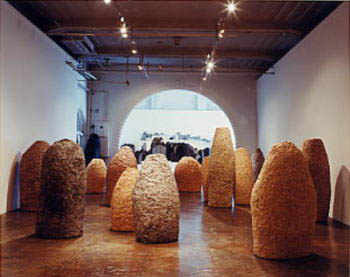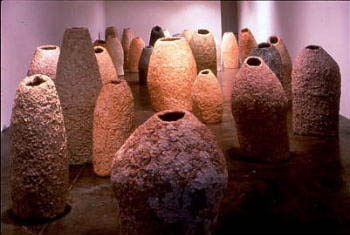“Where the soul is”

“Where the Soul is”
Bamboo structure on recycled Washi pulp,110-220c.m.h.
Sagacho Exhibit Space / Tokyo / Japan / 1997
Photo by Masayuki Hayashi
The human body is after all a vessel of the soul.
The spirit is going away from the body when people die.
The body is becoming empty and is going back to nature.
I started to create sculptures of human figures.
I feel emptiness when I make figurative sculptures as if I am making an empty body without a spirit.
Even if a sculpture of a human body is very splendid, it is no match for a living human body full of energy.
Life size simple shape vessels which have lost their soul, they are my expression of the existence of the human body.
Reiko Nireki

Nerimaku Museum / Tokyo / Japan / 1999
Photo by Yoshihiko Kominami
I continue to create art works on the theme of human existence in nature.
The cycle of nature is infinitely variable in the endless passing of time.
The existence of human beings is only a small part of magnificent nature.
I am working with the material of “paper”.
Paper started as a record, a means of communication and is used for many functions now.
It cannot be separated from the history of development of human civilization. I am most interested in combining the technique of traditional Japanese handmade paper called “Washi” with “recycled paper pulp”. Using natural materials, I want to create art works expressing that the human body is a part of nature and will go back to nature.
Reiko Nireki
Where the Soul is

“Where the Soul is “
Part of installation: drawings on Japanese Washi-paper
Photo by Yoshihiko Kominami
I was invited to a sculpture symposium in Kerala state in the south part of India 1997. My drawing installation “Where the Soul is 1997 ” is based on the sketches from my New Year visit to the holy place in Kanyakumari in Tamil- Nadu state where I went after the symposium.
Kanyakumari is located at the southernmost point of India. There is a beautiful cape called Comorin at the confluence of the Arabian Sea, the Indian Ocean and the Bengal Bay. People can look and pray towards the sunrise and the sunset from the Cape.
It was the time of pilgrimage. I saw beautiful scenery with thousands of pilgrims that came from all over India. They were entering the sea and performing ablution to pray towards the sunset. When the red sun was slowly sinking into the water, the silhouettes of people within nature were becoming one magnificent landscape.
That was an unforgettable sight.
I found a very simple way of life of human beings there.
Reiko Nireki
A Vessel of Soul
“The Human body is after all a vessel of soul”, Reiko Nireki says. The word “soul” rather than “mind” sounds somehow solemn and nostalgic. I am not so concerned about the naming, but I am sure she also has a reason to say simply “vessel” Nireki has abandoned figurative sculpture which would he empowered by imagining a soul residing in the figure. Her idea of a body and a soul also differs from the concept of soul as the master of the body in ancient Greece and that of the body as a graveyard of the soul or a shell which protects the soul.
Although the Ancient Greek philosophers considered an invisible soul more realistic than the vanity of a visible body, the comparison of reality and vanity is not important in as tar as both body and soul are used as metaphors for a human being. However, the theory of a human body as a mechanism might still have some significance. According to the theory of Descartes, the body as an accurate clock might experience a death somewhat like the stoppage of its clockwork.
I happened to see such samples of death at the exhibition “Human Body World ” in the National Science Museum. The epoch-making installation using a human body with its fluid taken out and filled and hardened with a kind of plastic, revealed the mechanical device packed under the skin in the body so vividly. It made me realize that there is an intimate relationship between the theory of the human body as a mechanism and the human organ transplants of today. No matter how much La Meltrie following Descartes tried to connect a body with a soul hy modifying the clockwork into a machanism which works by itself, the body remains a mere function until we deal with the primary cause of life.
Contrary to the ahove mentioned human specimen, Nirekis “vessel” is empty without the inner mechanism, and is literally a mere Vessel or a surface skin, neither moving nor heing still belween existence and non-existence. Her vessels has the content ot a soul or a substance which is inseparable from the body, or the body itself. However, Nireki has never refered to the word “body”. For Nireki, who is a formative artist, to think means to create figures which are extending and spacial. The vessel where a soul resides is not a mere signal but rather the suhstance itself.
The artist has departed from figurative sculpture hecause she could not find a meaning in the skills which merely imitate the human body. Later, she moved to Europe and resumed work on figures with organic materials, which she had previously intended to do. At that time Nireki again encountered nothing hut human beings. Now, she is encountering human heings constituents of nature and society, who inevitahty get involved in their environment and repest the cycle of birth and desth. A human being who is an individual is also a part of a herd at the same time. Nirekis expression is not a single figure nor does she indicate its condition. She questions the way it IS rather than the reason for its being.
You might imagine the works of Abacanowicz, especially the group of human backs, made mainly of linen. These figures apparently carry the grave history of the artist’s home country, Poland. Recently, a more severe and delicate theme called “war game” has been added to her works. However, Reiko Nireki has not experienced the war. She was born and raised in Japan after the war. Recently, she returned to Japan from England and also Germany. Nireki has looked into the material of her own language in order to express her personal experiences in various places. She recognized it directly in the form of her works.
She encountered jute linen in London and developed that encounter in India. In Germany, she worked with cast recycled paper, modeled on an iron structure. In Japan she engaged in the time-consuming task of pasting recycled paper onto a bamboo model shaped like a bomb. These acts have nothing to do with so-catted ecology. Rather she has been searching for the common wave length among the souls of different histories and cultures.
In the end, the soul takes on the style of a metaphor. However, at the same time the style is a structure of the mind which has been taken out (said Shuichi Kato), then the soul of a different structure takes on a new style. The vessel made by Nireki is a visible style of a style-less soul. There is no doubt why the artist calls it a mere vessel ot a soul based on her feelings shout the limited life span of human beings. It might also reflect upon the hastiness in Japan. Nireki’s rest wish for her vessel of a soul is a natural being which tills the space like an echo from a distance, regardless of life and death.
Keinosuke Murata
Art Critic
Director of Taro Okamoto Museum